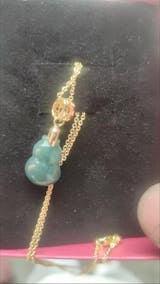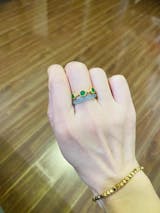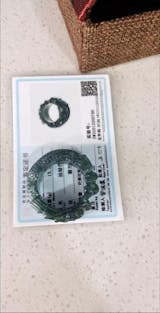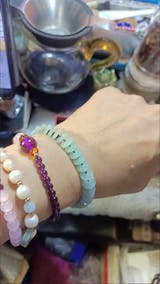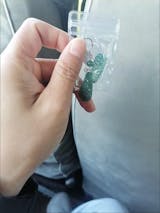How to Make A Lacquer Fan?A Guide for Beginners
Introduction
In the treasure trove of Chinese traditional craftsmanship, lacquer fans shine as radiant jewels, perfectly blending utilitarian objects with artistic creation. Using fans as canvases and lacquer as ink, these palm-sized masterpieces encapsulate centuries of artisan wisdom and Eastern aesthetics. This ancient art form, spanning over a thousand years, is now experiencing a modern renaissance through innovative reinterpretations.

I. Through the Ages: The Evolution of Lacquer Fans
1.1 Eastern Han Origins: The Birth of Lacquer Artistry
As early as the Eastern Han Dynasty (25–220 CE), lacquerware production had developed into a sophisticated system. When artisans mixed cinnabar into raw lacquer to paint cloud patterns on wooden bases, few could have imagined this technique would merge with handheld fans to create art. Historical records from The Book of Later Han note that nobility began adorning objects with lacquer, planting the seeds for lacquer fans.
1.2 Tang Dynasty Golden Age: Imperial Masterpieces
During the Tang Dynasty’s cultural zenith (618–907 CE), lacquer fans flourished as luxury items. Excavated relics from the Famen Temple crypt—such as gilded silver-inlaid fan handles—reveal extraordinary craftsmanship. Artisans employed gold and silver foil inlay techniques to etch celestial dancers and lotus motifs onto lacquer bases, transforming each court fan into a portable art gallery.

II. Decoding the Art: Four Pillars of Lacquer Fan Craftsmanship
2.1 The Alchemy of Technique: 108-Step Perfection
Traditional lacquer fan-making involves months of meticulous processes: framework carving, cloth layering, ash polishing, lacquer coating, and hand-painting. For example, Fuzhou’s bodiless lacquer technique requires over 30 rounds of polishing to achieve its iconic mirror-like finish—a testament to the artisan ethos of "perfecting the imperfect."
2.2 Philosophy in Form: Symbols of Harmony
Lacquer fan designs embody Taoist principles: round fans symbolize cosmic unity, while folding fans reflect the duality of expansion and contraction. Modern designers now fuse lacquer art with bamboo weaving and embroidery, creating innovative forms like collapsible "lantern fans," bridging ancient wisdom with contemporary style.

III. Reinventing Tradition: The Science & Revival of Urushi Lacquer
3.1 The Miracle of Urushi: Nature’s Indestructible Coating
Derived from lacquer tree sap, urushi resin contains urushiol—a compound granting unparalleled durability. Scientific studies confirm urushi coatings withstand temperatures from -40°C to 150°C and achieve a 6H pencil hardness rating. Today, this eco-friendly material is revolutionizing industries from aerospace to luxury furniture.
3.2 The "Floating Lacquer" Revolution: Democratizing Art
Addressing traditional barriers like long production cycles and allergy risks, modern artisans developed the "floating lacquer" technique. By swirling colored lacquer on water and imprinting patterns onto paper or fabric, this method allows anyone to create unique designs in minutes—bringing intangible cultural heritage into street markets and social media trends.

IV. Step-by-Step Guide to Crafting Lacquer Fans
4.1 Preparation Essentials
| Materials | Specifications | Pro Tips |
|---|---|---|
| Dye | Pre-mixed lacquer dyes (available online) | Opt for non-toxic, quick-drying formulas |
| Base | Plain folding/round fans or cardstock (for testing/bookmarks) | Use uncoated paper fans (120gsm+) for optimal absorption |
| Container | Deep bucket/trash can (min. 30cm depth) | Repurpose cleaned plastic storage bins |
| Tools | Mixing stick (chopsticks work), absorbent paper (recycled facial towels) | Wrap fan handles with painter’s tape to protect from dye |
4.2 Core Process Breakdown
| Stage | Instructions | Key Techniques |
|---|---|---|
| 1. Color Mixing | ① Combine 2-3 colors using "2 light + 1 dark" or "2 warm + 1 cool" rule ② Swirl gently with stick (2-3 rotations max) |
Avoid overmixing – organic marbling effects emerge from minimal agitation |
| 2. Color Testing | Dip cardstock corner to preview patterns | Test multiple angles: vertical dip (stripes) vs. Z-dip (waves) |
| 3. Fan Dipping | ① Submerge fan fully/partially ② Lift slowly at 45° angle ③ Air-dry vertically |
Rotate fan mid-dip for spiral designs Re-dip after drying for layered effects |
| 4. Cleanup | Skim residual dye with paper towels between color batches | Reuse leftover dye water for grad |

Conclusion
The journey of lacquer fans—from Han Dynasty workshops to TikTok tutorials—reveals a profound truth: cultural heritage thrives through adaptation. These shimmering artifacts are no longer frozen in museum cases but live vibrantly in hands crafting marbled patterns at pop-up studios and classrooms. As modern techniques like floating lacquer democratize access and 3D-printed frames push design boundaries, the essence remains unchanged: every stroke of lacquer still carries the patience of Tang artisans and the philosophy of yin-yang balance. To hold a lacquer fan today is to grasp a living dialogue between millennia-old wisdom and contemporary creativity—a testament to how tradition evolves when we dare to reimagine its forms while honoring its soul.
Related articles:
Discovering the Beauty of Lacquer Fan:Make A Unique Artwork
Exploring Lacquer Art:History,Applications and Significance























































